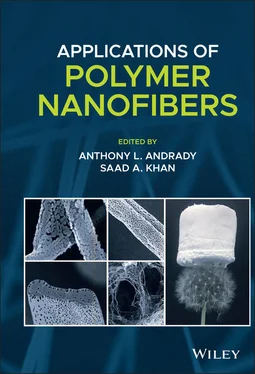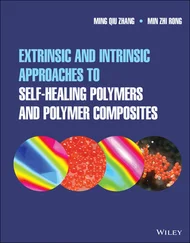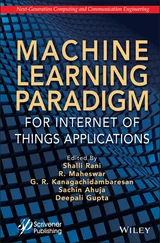Applications of Polymer Nanofibers
Здесь есть возможность читать онлайн «Applications of Polymer Nanofibers» — ознакомительный отрывок электронной книги совершенно бесплатно, а после прочтения отрывка купить полную версию. В некоторых случаях можно слушать аудио, скачать через торрент в формате fb2 и присутствует краткое содержание. Жанр: unrecognised, на английском языке. Описание произведения, (предисловие) а так же отзывы посетителей доступны на портале библиотеки ЛибКат.
- Название:Applications of Polymer Nanofibers
- Автор:
- Жанр:
- Год:неизвестен
- ISBN:нет данных
- Рейтинг книги:4 / 5. Голосов: 1
-
Избранное:Добавить в избранное
- Отзывы:
-
Ваша оценка:
- 80
- 1
- 2
- 3
- 4
- 5
Applications of Polymer Nanofibers: краткое содержание, описание и аннотация
Предлагаем к чтению аннотацию, описание, краткое содержание или предисловие (зависит от того, что написал сам автор книги «Applications of Polymer Nanofibers»). Если вы не нашли необходимую информацию о книге — напишите в комментариях, мы постараемся отыскать её.
Explore a comprehensive review of the practical experimental and technological details of polymer nanofibers with a leading new resource Applications of Polymer Nanofibers
Applications of Polymer Nanofibers
Applications of Polymer Nanofibers
Applications of Polymer Nanofibers — читать онлайн ознакомительный отрывок
Ниже представлен текст книги, разбитый по страницам. Система сохранения места последней прочитанной страницы, позволяет с удобством читать онлайн бесплатно книгу «Applications of Polymer Nanofibers», без необходимости каждый раз заново искать на чём Вы остановились. Поставьте закладку, и сможете в любой момент перейти на страницу, на которой закончили чтение.
Интервал:
Закладка:
49 Hu, Y. and Huang, Z.M. (2007). Numerical study on two‐phase flow patterns in coaxial electrospinning. Journal of Applied Physics 101 (8): 7.
50 Hu, X., Liu, S., Zhou, G. et al. (2014). Electrospinning of polymeric nanofibers for drug delivery applications. Journal of Controlled Release 185 (1): 12–21.
51 Huang, L., McMillan, R.A., Apkarian, R.P. et al. (2000). Generation of synthetic elastin‐mimetic small diameter fibers and fiber networks. Macromolecules 33 (8): 2989–2997.
52 Hutmacher, D.W. and Dalton, P.D. (2011). Melt electrospinning. Chemistry ‐ An Asian Journal 6 (1): 44–56.
53 Jagur‐Grodzinski, J. (2006). Nanostructured polyolefins/clay composites: role of the molecular interaction at the interface. Polymers for Advanced Technologies 17 (April): 395–418.
54 Jalaja, K., Naskar, D., Kundu, S.C., and James, N.R. (2016). Potential of electrospun core‐shell structured gelatin‐chitosan nanofibers for biomedical applications. Carbohydrate Polymers 136: 1098–1107.
55 Jarusuwannapoom, T., Hongrojjanawiwat, W., Jitjaicham, S. et al. (2005). Effect of solvents on electro‐spinnability of polystyrene solutions and morphological appearance of resulting electrospun polystyrene fibers. European Polymer Journal 41 (3): 409–421.
56 Kalra, V., Lee, J.H., Park, J.H. et al. (2009). Confined assembly of asymmetric block‐copolymer nanofibers via multiaxial jet electrospinning. Small 5 (20): 2323–2332.
57 Katsogiannis, K.A.G., Vladisavljević, G.T., and Georgiadou, S. (2015). Porous electrospun polycaprolactone (PCL) fibres by phase separation. European Polymer Journal 69: 284–295.
58 Katsogiannis, K.A.G., Vladisavljević, G.T., and Georgiadou, S. (2016). Porous electrospun polycaprolactone fibers: effect of process parameters. Journal of Polymer Science Part B: Polymer Physics 54 (18): 1878–1888.
59 Koombhongse, S., Liu, W., and Reneker, D.H. (2001). Flat polymer ribbons and other shapes by electrospinning. Journal of Polymer Science Part B: Polymer Physics 39 (1): 2598–2606.
60 Larrondo, L. and St. John Manley, R. (1981). Electrostatic fiber spinning from polymer melts. I. Experimental observations on fiber formation and properties. Journal of Polymer Science: Polymer Physics 19: 909–920.
61 Li, Z. and Wang, C. (2013). Effects of working parameters on electrospinning. In: One‐Dimensional Nanostructures: Electrospinning Technique and Unique Nanofibers (eds. Z. Li and C. Wang), 15–28. Heidelberg, New York: Springer‐Verlag Berlin.
62 Li, D. and Xia, Y. (2004). Electrospinning of nanofibers: reinventing the wheel? Advanced Materials 16 (14): 1151–1170.
63 Li, F., Zhao, Y., and Song, Y. (2010). Core‐shell nanofibers: nano channel and capsule by coaxial electrospinning. In: Nanofibers (ed. A. Kumar), 419–438. InTech.
64 Li, X., Su, Y., Liu, S. et al. (2010). Encapsulation of proteins in poly(l‐lactide‐co‐caprolactone) fibers by emulsion electrospinning. Colloids and Surfaces B: Biointerfaces 75 (2): 418–424.
65 Lin, T., Wang, H., Wang, H., and Wang, X. (2004). The charge effect of cationic surfactants on the elimination of fibre beads in the electrospinning of polystyrene. Nanotechnology 15 (9): 1375–1381.
66 Luo, C.J., Nangrejo, M., and Edirisinghe, M. (2010). A novel method of selecting solvents for polymer electrospinning. Polymer (Guildf) 51 (7): 1654–1662.
67 Luo, C.J., Stride, E., and Edirisinghe, M. (2012). Mapping the influence of solubility and dielectric constant on electrospinning polycaprolactone solutions. Macromolecules 45 (11): 4669–4680.
68 Lyons, J., Li, C., and Ko, F. (2004). Melt‐electrospinning part I: processing parameters and geometric properties. Polymer (Guildf) 45 (22): 7597–7603.
69 Ma, H., Hsiao, B.S., and Chu, B. (2014). Functionalized electrospun nanofibrous microfiltration membranes for removal of bacteria and viruses. Journal of Membrane Science 452: 446–452.
70 Manasco, J.L., Saquing, C.D., Tang, C., and Khan, S.A. (2012). Cyclodextrin fibers via polymer‐free electrospinning. RSC Advances 2 (9): 3778–3784.
71 Mao, X.W., Hatton, T.A., and Rutledge, G.C. (2013). A review of electrospun carbon fibers as electrode materials for energy storage. Current Organic Chemistry 17 (13): 1390–1401.
72 Maretschek, S., Greiner, A., and Kissel, T. (2008). Electrospun biodegradable nanofiber nonwovens for controlled release of proteins. Journal of Controlled Release 127 (2): 180–187.
73 McKee, M.G., Wilkes, G.L., Colby, R.H., and Long, T.E. (2004). Correlations of solution rheology with electrospun fiber formation of linear and branched polyesters. Macromolecules 37 (5): 1760–1767.
74 McKee, M.G., Hunley, M.T., Layman, J.M., and Long, T.E. (2006). Solution rheological behavior and electrospinning of cationic polyelectrolytes. Macromolecules 39 (2): 575–583.
75 McKee, M.G., Layman, J.M., Cashion, M.P., and Long, T.E. (2006). Phospholipid nonwoven electrospun membranes. Science 311 (5759): 353–355.
76 Mit‐uppatham, C., Nithitanakul, M., and Supaphol, P. (2004). Ultratine electrospun polyamide‐6 fibers: effect of solution conditions on morphology and average fiber diameter RID C‐4353‐2008. Macromolecular Chemistry and Physics 205 (17): 2327–2338.
77 Moghe, A.K. and Gupta, B.S. (2008). Co‐axial electrospinning for nanofiber structures: preparation and applications. Polymer Reviews 48 (2): 353–377.
78 Muthiah, P., Hsu, S.H., and Sigmund, W. (2010). Coaxially electrospun PVDF‐teflon AF and teflon AF‐PVDF core‐sheath nanofiber mats with superhydrophobic properties. Langmuir 26 (15): 12483–12487.
79 Nain, A.S. and Wang, J. (2013). Polymeric nanofibers: isodiametric design space and methodology for depositing aligned nanofiber arrays in single and multiple layers. Polymer Journal 45 (7): 695–700.
80 Natarajan, L., New, J., Dasari, A. et al. (2014). Surface morphology of electrospun PLA fibers: mechanisms of pore formation. RSC Advances 4 (83): 44082–44088.
81 Niu, H., Wang, X., and Lin, T. (2011). Needleless electrospinning: developments and performances. In: Nanofibers ‐ Production, Properties and Functional Applications (ed. T. Lin), 17–36. Norderstedt, Germany: Books on Demand.
82 Norton, C.L. (1936). Method of and apparatus for producing fibrous or filamentary material. US Patent 20,486,51A, issued 1936. 21 July 1936.
83 Nuansing, W., Frauchiger, D., Huth, F. et al. (2013). Electrospinning of peptide and protein fibres: approaching the molecular scale. Faraday Discussions 166: 209–221.
84 Nuansing, W., Georgilis, E., de Oliveira, T.V.A.G. et al. (2014). Electrospinning of tetraphenylporphyrin compounds into wires. Particle and Particle Systems Characterization 31 (1): 88–93.
85 Nurwaha, D. and Wang, X. (2015). Free surface electrospinning: investigation of the combined effects of process parameters on the morphology of electrospun fibers. Fibers and Polymers 16 (4): 850–866.
86 Ogata, N., Shimada, N., Yamaguchi, S. et al. (2007). Melt‐electrospinning of poly(ethylene terephthalate) and polyalirate. Journal of Applied Polymer Science 105: 1127–1132.
87 Pai, C.L., Boyce, M.C., and Rutledge, G.C. (2009). Morphology of porous and wrinkled fibers of polystyrene electrospun from dimethylformamide. Macromolecules 42 (6): 2102–2114.
88 Park, J.H. and Braun, P.V. (2010). Coaxial electrospinning of self‐healing coatings. Advanced Materials 22 (4): 496–499.
89 Persano, L., Camposeo, A., Tekmen, C., and Pisignano, D. (2013). Industrial upscaling of electrospinning and applications of polymer nanofibers: a review. Macromolecular Materials and Engineering 298 (5): 504–520.
90 Praeger, M., Saleh, E., Vaughan, A. et al. (2012). Fabrication of nanoscale glass fibers by electrospinning. Applied Physics Letters 100 (6): 063114.
Читать дальшеИнтервал:
Закладка:
Похожие книги на «Applications of Polymer Nanofibers»
Представляем Вашему вниманию похожие книги на «Applications of Polymer Nanofibers» списком для выбора. Мы отобрали схожую по названию и смыслу литературу в надежде предоставить читателям больше вариантов отыскать новые, интересные, ещё непрочитанные произведения.
Обсуждение, отзывы о книге «Applications of Polymer Nanofibers» и просто собственные мнения читателей. Оставьте ваши комментарии, напишите, что Вы думаете о произведении, его смысле или главных героях. Укажите что конкретно понравилось, а что нет, и почему Вы так считаете.












